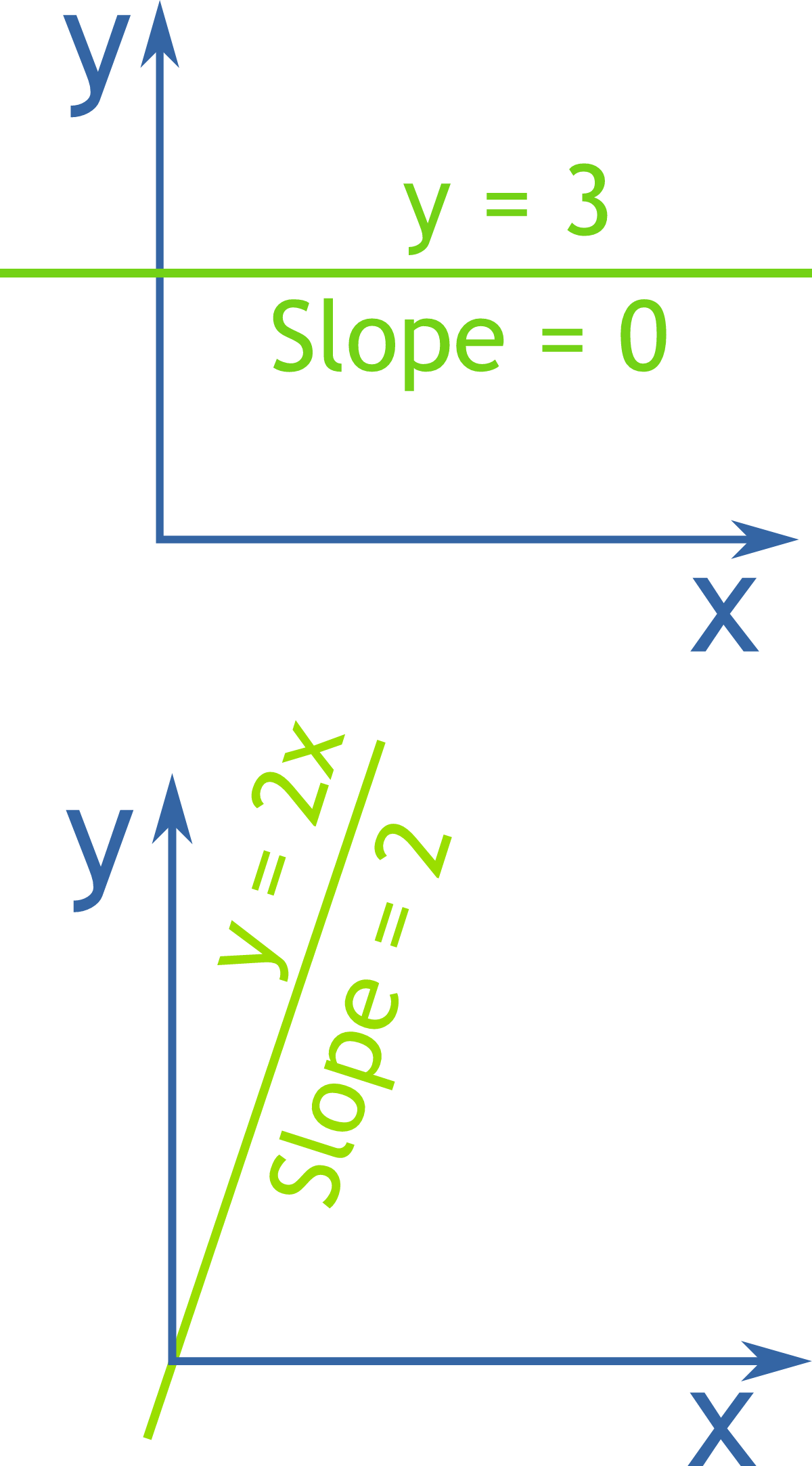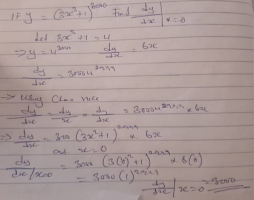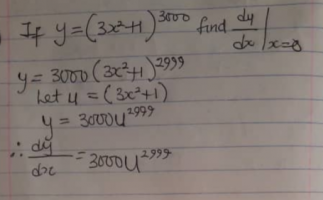You are using an out of date browser. It may not display this or other websites correctly.
You should upgrade or use an alternative browser.
You should upgrade or use an alternative browser.
If y = (3x^2+1)^3000, find dy/dx| x=0
- Thread starter ugu
- Start date
which is correct then?The second part of the 3rd line says [imath]\frac{dy}{dx}=6x[/imath], and the 4th line says [imath]\frac{dy}{d\mathbf x} = 3000u^{2999}[/imath]. Both are incorrect.
Harry_the_cat
Elite Member
- Joined
- Mar 16, 2016
- Messages
- 3,784
It is your notation that is incorrect. Where is dy/du and du/dx ?
Also, have another look at your last line. What is 6(0) ?
Also, have another look at your last line. What is 6(0) ?
pka
Elite Member
- Joined
- Jan 29, 2005
- Messages
- 11,990
[imath]y = {\left( {3{x^2} + 1} \right)^{3000}},\quad {\left. {\dfrac{{dy}}{{dx}}} \right|_{x = 0}}[/imath], This is exactly what was posted.QUESTION
View attachment 30105
My question to ugudansam is: why not simply use to chain rule in one step?
[imath] \dfrac{dy}{dx}=3000\left(3x^2+1\right)^{2999}\left(6x\right)=18000x\left(3x^2+1\right)^{2999}~.[/imath]
Is it not clear now what the value of the derivative at [imath]x=0 \text{ is }~?[/imath]
because, am still learning, i am still trying to figure out the easier method[imath]y = {\left( {3{x^2} + 1} \right)^{3000}},\quad {\left. {\dfrac{{dy}}{{dx}}} \right|_{x = 0}}[/imath], This is exactly what was posted.
My question to ugudansam is: why not simply use to chain rule in one step?
[imath] \dfrac{dy}{dx}=3000\left(3x^2+1\right)^{2999}\left(6x\right)=18000x\left(3x^2+1\right)^{2999}~.[/imath]
Is it not clear now what the value of the derivative at [imath]x=0 \text{ is }~?[/imath]
Last edited by a moderator:
[imath]y = {\left( {3{x^2} + 1} \right)^{3000}},\quad {\left. {\dfrac{{dy}}{{dx}}} \right|_{x = 0}}[/imath], This is exactly what was posted.
My question to ugudansam is: why not simply use to chain rule in one step?
[imath] \dfrac{dy}{dx}=3000\left(3x^2+1\right)^{2999}\left(6x\right)=18000x\left(3x^2+1\right)^{2999}~.[/imath]
Is it not clear now what the value of the derivative at [imath]x=0 \text{ is }~?[/imath]
But this also has not been simplify to the answer, as it?[imath]y = {\left( {3{x^2} + 1} \right)^{3000}},\quad {\left. {\dfrac{{dy}}{{dx}}} \right|_{x = 0}}[/imath], This is exactly what was posted.
My question to ugudansam is: why not simply use to chain rule in one step?
[imath] \dfrac{dy}{dx}=3000\left(3x^2+1\right)^{2999}\left(6x\right)=18000x\left(3x^2+1\right)^{2999}~.[/imath]
Is it not clear now what the value of the derivative at [imath]x=0 \text{ is }~?[/imath]
pka
Elite Member
- Joined
- Jan 29, 2005
- Messages
- 11,990
Dr.Peterson
Elite Member
- Joined
- Nov 12, 2017
- Messages
- 16,854
There are several ways you can apply the chain rule; using u as you evidently have been taught is valid (though you are expected to outgrow it). But you have to do it carefully. Here you made several mistakes, from writing y on the second line when you surely meant y', to leaving off the derivative of u in the last line.
Here is one page that (near the bottom) differentiates a function twice, once using f(g(x)) notation, and again using your form with u:

Derivative Rules
The Derivative tells us the slope of a function at any point. There are rules we can follow to find many derivatives.
www.mathsisfun.com
Here is another that teaches something more like pka's approach, which is mine:
Calculus I - Chain Rule
In this section we discuss one of the more useful and important differentiation formulas, The Chain Rule. With the chain rule in hand we will be able to differentiate a much wider variety of functions. As you will see throughout the rest of your Calculus courses a great many of derivatives you...
tutorial.math.lamar.edu
And the following page starts with many examples using your approach, then transitions to the more mature "direct" approach at the end (part 5):
When I teach this, I draw a box around the "inside" part (your u) and suggest thinking of that as if it were a variable, differentiating, and then multiplying by the derivative of what's in the box.
ok sir, i will check to see and try adjusting the mistakesThere are several ways you can apply the chain rule; using u as you evidently have been taught is valid (though you are expected to outgrow it). But you have to do it carefully. Here you made several mistakes, from writing y on the second line when you surely meant y', to leaving off the derivative of u in the last line.
Here is one page that (near the bottom) differentiates a function twice, once using f(g(x)) notation, and again using your form with u:

Derivative Rules
The Derivative tells us the slope of a function at any point. There are rules we can follow to find many derivatives.www.mathsisfun.com
Here is another that teaches something more like pka's approach, which is mine:
Calculus I - Chain Rule
In this section we discuss one of the more useful and important differentiation formulas, The Chain Rule. With the chain rule in hand we will be able to differentiate a much wider variety of functions. As you will see throughout the rest of your Calculus courses a great many of derivatives you...tutorial.math.lamar.edu
And the following page starts with many examples using your approach, then transitions to the more mature "direct" approach at the end (part 5):
When I teach this, I draw a box around the "inside" part (your u) and suggest thinking of that as if it were a variable, differentiating, and then multiplying by the derivative of what's in the box.
it takes about one month to get to that level of the course. I left high school more than 18 years ago. There is no way to have a one on one with the instructor has we are just rushing and it is being taught on whatsapp and not real math platform.That is almost completely wrong. Your having to use a u-substitution tells me that you know very little about this.
If I were you, I would seek a sitdown session with my instructor.
= 0[imath]y = {\left( {3{x^2} + 1} \right)^{3000}},\quad {\left. {\dfrac{{dy}}{{dx}}} \right|_{x = 0}}[/imath], This is exactly what was posted.
My question to ugudansam is: why not simply use to chain rule in one step?
[imath] \dfrac{dy}{dx}=3000\left(3x^2+1\right)^{2999}\left(6x\right)=18000x\left(3x^2+1\right)^{2999}~.[/imath]
Is it not clear now what the value of the derivative at [imath]x=0 \text{ is }~?[/imath]
I agree that as you gain experience you will use u-substitutions less frequently and that you will use the chain rule without intermediate steps. But
[math]\text {Given } y = (3x^2 + 1)^{3000}, \text { find } \dfrac{dy}{dx} \text { at } x = 0.[/math]
Start by finding dy/dx. If you use a u-substitution, that means
[math]\dfrac{dy}{dx} = \dfrac{dy}{du} * \dfrac{du}{dx}.[/math]
[math]u = 3x^2 + 1 \implies \dfrac{du}{dx} = 6x \text { and } y = u^{3000}.[/math]
[math]y = u^{3000} \implies \dfrac{dy}{du} = 3000u^{2999}.[/math]
[math]\therefore \dfrac{dy}{dx} = \dfrac{dy}{du} * \dfrac{du}{dx} = 3000u^{2999} * 6x = 18000x(3x^2 + 1)^{2900}.[/math]
Now substitute 0 for x. What do you get?
Your method works if you follow it carefully.
[math]\text {Given } y = (3x^2 + 1)^{3000}, \text { find } \dfrac{dy}{dx} \text { at } x = 0.[/math]
Start by finding dy/dx. If you use a u-substitution, that means
[math]\dfrac{dy}{dx} = \dfrac{dy}{du} * \dfrac{du}{dx}.[/math]
[math]u = 3x^2 + 1 \implies \dfrac{du}{dx} = 6x \text { and } y = u^{3000}.[/math]
[math]y = u^{3000} \implies \dfrac{dy}{du} = 3000u^{2999}.[/math]
[math]\therefore \dfrac{dy}{dx} = \dfrac{dy}{du} * \dfrac{du}{dx} = 3000u^{2999} * 6x = 18000x(3x^2 + 1)^{2900}.[/math]
Now substitute 0 for x. What do you get?
Your method works if you follow it carefully.



